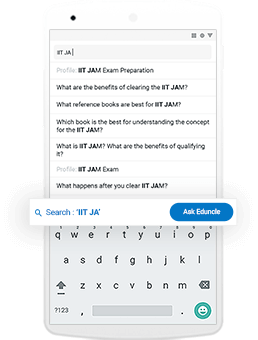Time management is very much important in IIT JAM. The eduncle test series for IIT JAM Mathematical Statistics helped me a lot in this portion. I am very thankful to the test series I bought from eduncle.
Nilanjan Bhowmick AIR 3, CSIR NET (Earth Science)Do You Want Better RANK in Your Exam?
Start Your Preparations with Eduncle’s FREE Study Material
- Updated Syllabus, Paper Pattern & Full Exam Details
- Sample Theory of Most Important Topic
- Model Test Paper with Detailed Solutions
- Last 5 Years Question Papers & Answers
Sign Up to Download FREE Study Material Worth Rs. 500/-

















Ketan kiran naik![best-answer]()
Definition: Under Halsey Plan, the standard time for the completion of a job is fixed and the rate per hour is then determined. If the time taken by a worker is more than the standard time, then he shall be paid according to the time rate, i.e. time taken multiplied by the rate per hour. Under Halsey premium plan method, standard time for doing each job or operation is fixed and the worker is given wages for the actual time he takes to complete the job or operation at the agreed rate per hour plus a bonus equal to (usually) one-half of the wages of the time saved. In practice, the bonus may vary from 33½ % to 66½ % of the wages of the time saved. If there is no saving in the standard time allowance, the worker is paid only his day rate. Thus, if S is standard time, T the time taken, R the labour rate per hour, and % the percentage of the wages of time saved to be given as bonus, total earnings of the worker will be..it is thr in attachment. Definition: Under Rowan Plan, the standard time for the completion of a job and the rate per hour is fixed. If the time taken by the worker is more than the standard time, then he is paid according to the time rate, i.e. time taken multiplied by the rate per hour. In case, the worker completes the work in less than the standard time; then he is entitled to a bonus along with the time wages. A bonus is the percentage of worker’s time rate. This means, the bonus/premium is calculated on the percentage of wages earned for working on a job and is not calculated for the time-saved, as in the case of Halsey Plan. This percentage is equivalent to the proportion of the time saved to the standard time. Numerically, Bonus = Time Saved/ Standard Time The incentive scheme under Rowan Plan can be illustrated by the examples given below: Standard Time = 8 hrs Rate per hour = Rs 2 Case (1): Time Taken = 8 hrs Earnings = 8 x 2 = Rs 16 Case (2): Time Taken = 10 hrs Earnings = 10 x 2 = Rs 20 Case (3): Time taken = 6 hrs Earnings: Time Wages = 6 x 2 = Rs 12 Bonus = 2/8 X 6 = Rs 1.5 Thus, in the above example, the worker completing the work in 6 hrs, less than the standard time, the total earnings will be Rs 13.50 (time wages+bonus).